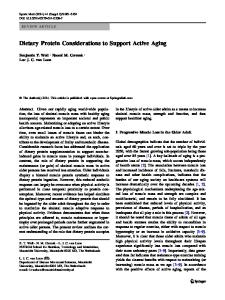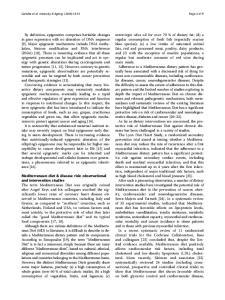Dietary Patterns, Diabetes, and Aging
- PDF / 226,493 Bytes
- 5 Pages / 595.276 x 790.866 pts Page_size
- 53 Downloads / 268 Views
OBESITY AND DIABETES (SML RIBEIRO, SECTION EDITOR)
Dietary Patterns, Diabetes, and Aging Rita de Cássia de Aquino 1,2
3
& Ágatha Nogueira Previdelli & Érica Line de Oliveira Pedron
1,4
& Adriana Machado-Lima
1
Accepted: 26 October 2020 # Springer Science+Business Media, LLC, part of Springer Nature 2020
Abstract Purpose of Review Several studies have suggested that eating patterns are associated with healthy aging and lower risk of diseases such as diabetes. The purpose of this paper is to review recent publications about dietary patterns, diabetes, and aging. Recent Findings The most robust research available on dietary patterns to reduce the risk of diabetes mainly indicates Mediterranean-style, DASH diet, vegetarian or vegan, and low-carb diet plans. Summary An optimal dietary pattern for healthy aging and the treatment of diabetes should emphasize plant-based food (vegetables, beans, nuts and seeds, fruits, and whole intact grains), fish and other seafood, olive oil as the principal source of dietary fat; low-fat dairy products (mainly yoghurt and cheese) in low to moderate amounts; minimized consumption of refined grains; and preference of whole foods over highly processed foods. Further research on this topic is needed. Keywords Dietary patterns . Elderly . Diabetes
Introduction People worldwide are living longer. Today, for the first time in history, most people can expect to live into their sixties and beyond. By 2050, the world’s population aged 60 years and older is expected to total 2 billion, up from 900 million in
This article is part of the Topical Collection on Obesity and Diabetes * Rita de Cássia de Aquino [email protected] Ágatha Nogueira Previdelli [email protected] Érica Line de Oliveira Pedron [email protected] Adriana Machado-Lima [email protected] 1
Graduate Program in the Sciences of Aging, São Judas Tadeu University (USJT), Rua Taquari, 546, Mooca, São Paulo, SP CEP: 03166-000, Brazil
2
Rua Nilo, 35 apto 61, Aclimação, São Paulo, SP CEP 01533-010, Brazil
3
Nutrition Program, São Judas Tadeu University, Rua Taquari, 546, Mooca, São Paulo, SP CEP: 03166-000, Brazil
4
Rua Dr. Vital Brazil, 241, apto 101, bloco 01, Vila Santa Luzia, São Bernardo do Campo, SP CEP 09664-000, Brazil
2015, and by 2050, 434 million people will be in this age group worldwide [1]. At the biological level, aging results from the impact of the accumulation of a wide variety of molecular and cellular damage over time. This leads to a gradual decrease in physical and mental capacity, a growing risk of disease, and, ultimately, death. But these changes are neither linear nor consistent, and they are only loosely associated with a person’s age in years. While some 70-year-olds enjoy extremely good health and functioning, others are frail and require significant help from others [2]. One of the key modifiable factors that influence healthy aging is nutrition. Research on nutrition has focus on the effects of nutrients or foods on health outcomes. Nevertheless, foods are combined into meals
Data Loading...











